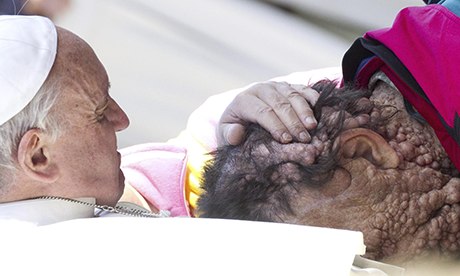
Pope Francis blesses a man, suffering from neurofibromatosis, in Saint Peter's Square at the end of his General Audience in Vatican City. Photograph: Claudio Peri/EPA
We live in a world of image-conscious leaders, hair primped, faces artfully powdered, photo opportunities carefully devised. The art of image is generally assumed to be both modern and false: the term spin doctor was unknown in Britain before Tony Blair's team made it part of the language. Yet for all the sophistication of modern political style, Pope Francis is showing by his superior example how tired, unconvincing and alienating such methods have become.
Francis has renovated a damaged brand not in years, but months. He has turned the image of the papacy and by extension the Catholic church upside down in less than a year. His papacy already seems destined to be remembered as special – and yet this communicational triumph has not been achieved through carefully constructed PR techniques. It is not spin. Its methods are medieval and its magic is simple.
This week's images of the pope kissing and praying with a man severely disfigured by illness are truly gothic. I do not say that intending to belittle or caricature the condition, apparently neurofibromatosis, from which this man who attended the pope's general audience in the Vatican is suffering. What is gothic is the return to 13th-century values in this picture of a Christian leader showing humility and charity by physically interacting with someone visibly sick and visually different from those around him. St Francis of Assisi, whose name Pope Francis has adopted, was a master of simple, powerful popular gestures: he invented the Christmas crib and reputedly preached a sermon to the birds.
Disease, in the world of St Francis, was mysterious and awe-inspiring. There was virtually no effective medicine. The sufferings of Job were a reality for all those infected by illnesses no one understood. Few illnesses today can inspire the deep sense of awe that once attended leprosy and plague: so it is harder to inspire saintliness, kissing the boils of the sick. Francis has found a face so unusual and estranged from the normal that as he touches and prays with its possessor he seems to reenact the spirit of St Francis himself.
Is this a publicity stunt? No, because it expresses more than an empty gesture ever could. Charity and humility and love really are Christian ideals, and for someone in the pope's position of power to so graphically express them is full of concrete meaning. Be like Christ: identify with the outcast. This pope's idealism is so clearly readable in his actions that it is missing the point to call him a clever communicator. He knows that he is a living symbol and that by identifying with this man he is making the church itself grow more human.
Can politicians emulate this pope's bold symbolic language? They'd be laughed at and called cynics. So why can he get away with it? The word we are looking for is authenticity. Pope Francis appears utterly authentic and honest. He does not seem cynical in this image because we accept his sincerity and seriousness. This is what politicians have lost in modern democracies. It is why people turn to Russell Brand. There is a deep crisis of belief in democratically elected leaders but Pope Francis has the answer: you who seek to lead, look at this picture, it has a message for you.
A simple message. Do and say what you believe.

No comments:
Post a Comment